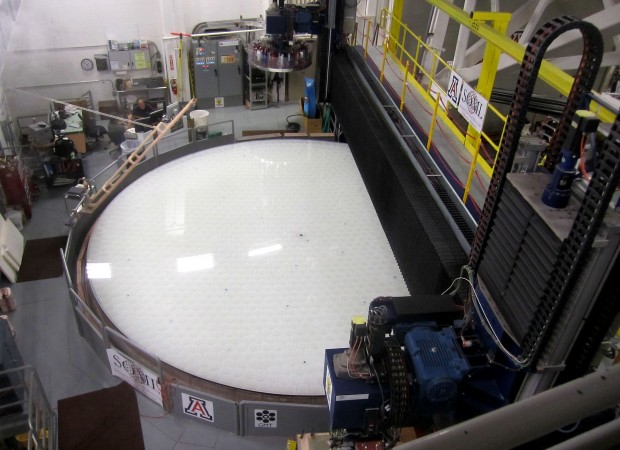Richard F. Caris Mirror Lab
 At the University of Arizona's Richard F. Caris Mirror Laboratory, a team of scientists and engineers is making giant, lightweight mirrors of unprecedented power for a new generation of optical and infrared telescopes.
At the University of Arizona's Richard F. Caris Mirror Laboratory, a team of scientists and engineers is making giant, lightweight mirrors of unprecedented power for a new generation of optical and infrared telescopes.
These mirrors represent a radical departure from the conventional solid-glass mirrors used in the past. They have a honeycomb structure on the inside; made out of Ohara E6-type borosilicate glass that is melted, molded and spun cast into the shape of a paraboloid in a custom-designed rotating oven. Honeycomb mirrors offer the advantages of their solid counterparts - rigidity and stability - but they can be significantly larger, and dramatically lighter. With their lightweight structure, air can be circulated through the honeycomb structure forcing the glass to reach thermal equilibrium with the air temperature in a relatively short time, on the order of 20-30 minutes.
The Mirror Lab team has also developed a revolutionary new method to polish the honeycomb mirrors with a deeply curved, parabolic surface that results in much shorter focal lengths than conventional mirrors. Such fast mirrors not only improve telescope performance, but they can fit into a much shorter telescope body that requires a smaller, less expensive enclosure. The typical focal ratios are of order f/1.25 to f/1.14.
The pioneering work being done today at the Richard F. Caris Mirror Lab had its beginning around 1980 with a backyard experiment by Dr. Roger Angel, the lab's founder and scientific director. Curious about the suitability of borosilicate glass (the kind used in glass ovenware) for making honeycomb structures, he tested the idea by fusing together two custard cups in an improvised kiln. The experiment was a success and led to a series of bigger kilns and small furnaces and, eventually, the spin casting of three 1.8 meter mirrors.
By 1985, with financial support primarily from the US Air Force, the National Science Foundation and the University of Arizona, Roger Angel (in photo at left) and a talented Mirror Lab team moved to the current facility under the east wing of the UA football stadium. A large, rotating furnace was built and a series of mirrors as big as 3.5 meters in diameter were successfully cast.
By 1990, the rotating furnace was expanded to its current size, and a new wing was added to the Mirror Lab to house two mirror polishing stations and a test tower. The new furnace, which is large enough to cast mirrors up to 8.4 m in diameter, was first used in 1992 to make a 6.5-m mirror. In January 1997 the first 8.4-m mirror for the Large Binocular Telescope (LBT) was completed.
As part of the technology development process, the Mirror Lab has successfully produced fourteen mirrors with diameters of 1.2, 1.5, 3.5, 6.5, and 8.4 m. Nearly all of these mirrors are now operating in telescopes including: the SAO 1.2-m f/1.9 on Mt. Hopkins, the Lennon 1.8-m f/1.0 on Mt. Graham, the ARC 3.5-m f/1.75 on Apache Point, NM, the WIYN 3.5-m f/1.75 on Kitt Peak and the Phillips Lab 3.5-m f/1.5 at Starfire Optical Range, NM. The 3.5-m mirrors and larger ones have been polished at the Mirror Lab using the stressed-lap polishing technique to produce a surface figure ~ +15 to +20 nm rms.
The Mirror Lab continues its impressive history of successful, ground breaking mirror castings. After a series of 1.2m and 3.5m mirrors proved the casting and polishing techniques, the oven was enlarged for the casting of 8-m class mirrors in 1991. In April 1992, the first 6.5-m f/1.25 honeycomb blank was successfully cast. This mirror went into operation in May 2000 as the MMT Conversion Project on Mt. Hopkins. In February 1994, the second 6.5-m f/1.25 honeycomb blank was cast. This mirror, for the Magellan Project, was installed at Las Campanas Observatory, Chile in 2001.

For Public
Public events include our Monday Night Lecture Series, world-reknowned Astronomy Camp and Mt Lemmon Sky Center.

For Students
A good place to start if you want to become an undergrad major or grad student, or need to find our schedule of classes.

For Scientists
Find telescopes and instruments, telescope time applications, staff and mountain contacts, and faculty and staff scientific interests.




